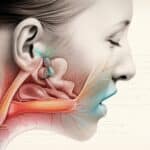Breaking the Sound Barrier: How to Alleviate Eustachian Tube Dysfunction Symptoms & Tinnitus
- Get link
- X
- Other Apps
Introduction
Ever experienced a sensation of blocked or clogged ears – like you were on an airplane? That’s often due to a condition called Eustachian Tube Dysfunction (ETD). Now imagine a constant ringing, buzzing, or high-pitched noise in your ears. That, my friend, is Tinnitus. Often, these conditions walk hand in hand, wreaking havoc on an individual’s life. Let’s dive into understanding ETD, its direct link with tinnitus, and how it impacts your quality of life.
What is Eustachian Tube Dysfunction?
Eustachian Tube Dysfunction happens when the Eustachian tubes – those small tubes connecting your middle ear to the upper throat and rear section of your nasal cavity – don’t function as they should. Meant to regulate ear pressure, they seem to go on strike, leaving your ears feeling full or painfully pressurized. It’s akin to needing an ‘ear tube surgery’ every time you yawn or swallow to alleviate ‘negative ear pressure.’ ETD symptoms range from roar discomfort to a downright painful ear pressure scenario, which we further explore in the article “Signs that Tinnitus Is Going Away“.
What is Tinnitus?
Tinnitus is, in simple words, a high-pitched concert playing continuously in your ears. It’s not limited to ringing – clicking, hissing, or roaring sounds are all part of the tinnitus spectrum. Different kinds of tinnitus, like pulsatile tinnitus and non-pulsatile tinnitus, manifest in various ways. Imagine ‘Ringing Ear Sounds’ echoing inside your ear all day long. The causes, ranging from age-related hearing loss to hypertension and migraines, are explored in the article “Kinds of Tinnitus“.
Symptoms of Tinnitus from Eustachian Tube Dysfunction
When ETD and Tinnitus decide to gang up on you, the symptoms can be agonizing. You experience negative ear pressure, creating a feeling that your ears are continually popping or feel stuffy. This ear fullness is often accompanied by a persistent ringing or buzzing noise. An incessant ‘Ringing Ear Sound Effect’ is common, making it difficult to concentrate on tasks or even catch some good sleep. More on this topic is covered in the article “Understanding Tinnitus“. One of the best sources for managing tinnitus and understanding what causes it is the American Tinnitus Association.
List of Symptoms for Tinnitus
With tinnitus, you can expect a barrage of ear-related symptoms. Regular attendees include the persistent ringing or buzzing, which could be high-pitched like a ‘Ringing Ear Sound’ or low-pitched like a humming sound. Your hearing may fluctuate, going back and forth between sharp sound clarity and muffled sounds, making you feel like you’re underwater.
Causes of Eustachian Tube Dysfunction and Tinnitus
ET and Tinnitus stem from different sources. ETD is usually the result of a poor cold, sinus infection, or allergy that inflames and irritates your Eustachian tubes. Tinnitus, on the other hand, frequently arises from prolonged exposure to loud noises and age-related hearing loss. However, when ETD is involved, the blocked condition of the tubes can significantly amplify the ear noise – the tinnitus. The obstruction traps the tinnitus sound within, making it more prominent. This crucial connection between ETD and tinnitus is meticulously discussed in “Ear infection cause Tinnitus“. When you combine these, it results in a mix-match of symptoms from both conditions, as detailed in “TMJ cause Tinnitus“.
Conditions that Cause Tinnitus
But ETD is not the only condition that can pave the way for Tinnitus. Other potential culprits include Temporomandibular Joint Disorder (TMJ), Meniere’s Disease, Vestibular Neuritis, or even Tumors in the auditory nerve. Age-related hearing loss and exposure to sudden or prolonged loud noise are also significant risk factors. To dive deeper into what might be causing your Tinnitus, check out “Conditions that Cause Tinnitus”.
Treatment and Management of ETD and Tinnitus
ETD and Tinnitus might seem threatening, but they can be treated and managed effectively. For ETD, treatments often start with decongestants, nasal sprays, allergies, or cold medications, all aimed at reducing inflammation. If it’s chronic or severe, minor surgery involving ear tubes might be needed to equalize pressure. In contrast, Tinnitus management usually involves sound therapies, counseling, hearing aids, and medications to suppress ear noise. The icing on the cake — lifestyle changes like stress management and avoiding loud noise exposure can make a significant difference. To dive into treatments and management options for ETD and Tinnitus, you can refer to “Understanding Tinnitus“, which covers a comprehensive look. For Tinnitus specific treatments, “Tinnitus Hearing Loss” is an excellent reference. Additionally, the Mayo Clinic is an authoritative source for all things Tinnitus.
Does Tinnitus from Eustachian Tube Dysfunction Go Away?
Oh, the million-dollar question! Many individuals suffering from ETD-induced Tinnitus wonder if it’s a life sentence. Truth be told, it all comes down to the root – if the ETD is treated effectively, the annoying ear noise (Tinnitus) can fade away. So, don’t let “Does Tinnitus Go Away?” bog you down. With the right treatment and management, you can reclaim your peace.
Impact of Eustachian Tube Dysfunction and Tinnitus on Life Quality
Living with a never-ending concert in your ears can be a daunting journey, let alone when paired with the pressure of ETD. It can affect your concentration, induce fatigue from lack of decent sleep, and lead to stress or anxiety. In severe cases, it can even impact social interactions. Indeed, “Tinnitus Worse when lying down” or ETD causing discomfort when swallowing can make you dread bedtime. Thank goodness, vast resources like the National Institute on Deafness and Other Communication Disorders provide extensive guidance through this journey.
Conclusion
Though ETD and Tinnitus can be bothersome, one doesn’t necessarily mean the other. However, if you’re stuck with both, understand that the ETD might be amplifying your tinnitus – it needs to be addressed. With appropriate treatment, lifestyle modifications, and a decent set of earplugs, you can keep the ‘phantom noise’ at bay, or you can kiss it goodbye! Remember, “Does Tinnitus Get Better?“. Absolutely! So, hang in there. You’ve got this. Until then, keep your focus on understanding tinnitus as explained in “Understanding Tinnitus“.
Eustachian Tube Dysfunction Symptoms Tinnitus - Frequently Asked Questions (FAQ)
Eustachian Tube Dysfunction (ETD) is a condition where the eustachian tubes, small passageways connecting your middle ear to your nasopharynx, fail to function properly. This can cause symptoms such as a sense of fullness in the ear, ear pain, muffled hearing, and tinnitus.
ETD can cause Tinnitus by creating a blocked condition in the eustachian tubes. This obstruction traps the sounds within the ear, causing a constant ringing or buzzing noise, a primary symptom of Tinnitus.
Yes, ETD-induced Tinnitus can often be managed successfully. Treatment usually involves addressing the underlying ETD. This might include medications to reduce inflammation and congestion or minor surgical procedures in some cases. Additionally, specific therapies and lifestyle changes can help manage the Tinnitus.
In some cases, minor surgery involving ear tubes might be required to equalize pressure and alleviate symptoms of ETD and associated Tinnitus. This is typically considered when other treatment methods are ineffective.
ETD and Tinnitus can potentially affect your quality of life. Persistent symptoms might lead to difficulties in concentrating, fatigue due to sleep disturbances, and induced stress or anxiety. In severe cases, it might even impact your social interactions. However, with proper diagnosis, treatment, and management, you can mitigate these influences substantially.
The post Breaking the Sound Barrier: How to Alleviate Eustachian Tube Dysfunction Symptoms & Tinnitus appeared first on Pulsatile Tinnitus Treatments News - Tinnitus Relief.
Related posts:
https://ift.tt/whyZW7o
#tinnitus #pusatiletinnitus #earringing #whatistinnitus #howtostoptinnitus
- Get link
- X
- Other Apps



Comments
Post a Comment